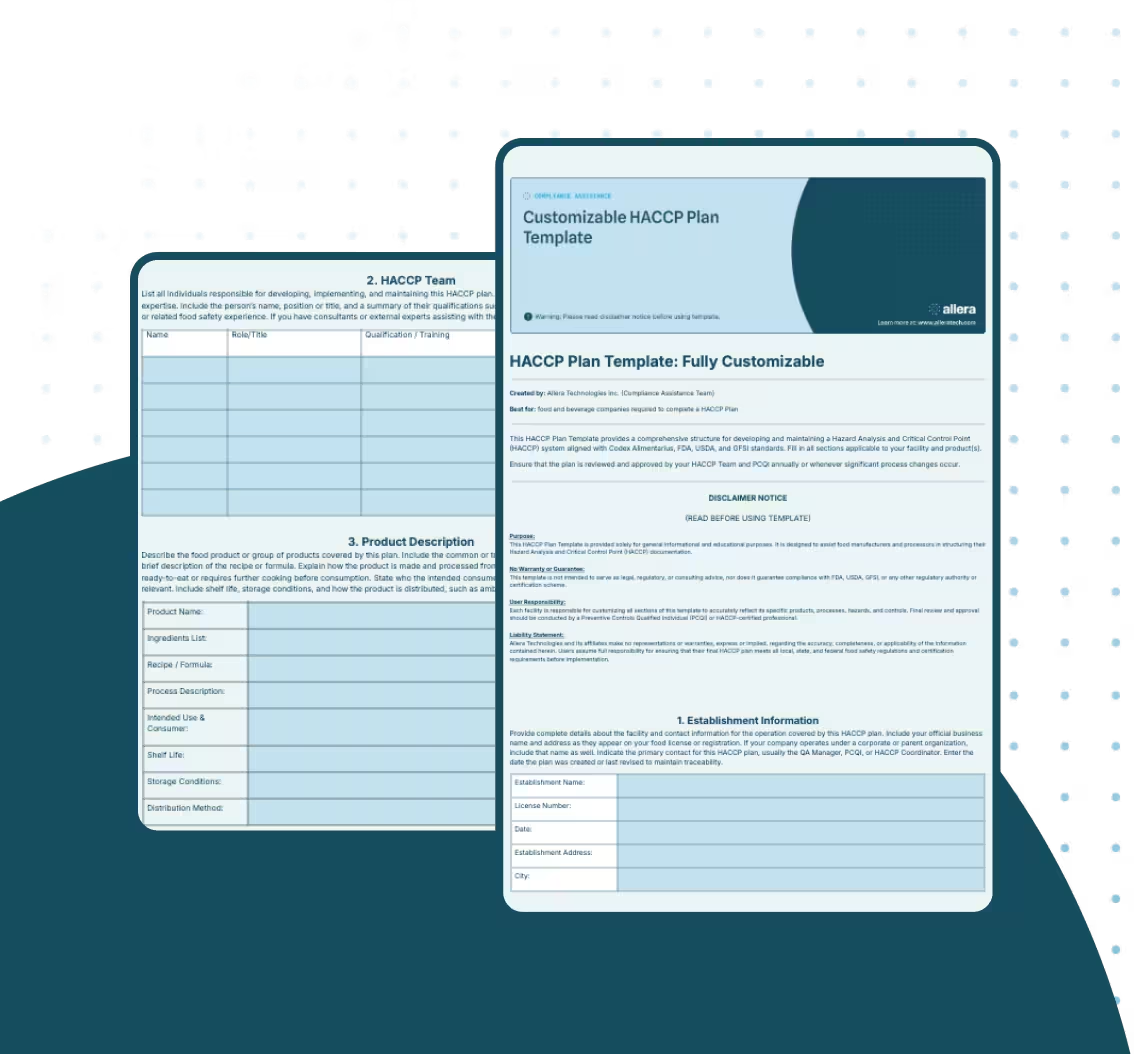Key Takeaways:
- Principle 1: Conduct a hazard analysis to identify biological, chemical, and physical risks at every production stage.
- Principle 2: Determine Critical Control Points (CCPs) where hazards can be prevented, eliminated, or reduced.
- Principle 3: Establish measurable critical limits that define safe operating conditions.
- Principle 4: Set up monitoring procedures to ensure critical limits are consistently met.
- Principle 5: Define corrective actions to address deviations and prevent recurrence.
- Principle 6: Implement verification procedures to confirm your HACCP system works as intended.
- Principle 7: Maintain thorough records to prove compliance and support continuous improvement.
TL;DR: This article explains why HACCP is essential for building a proactive, science-based food safety system in manufacturing. It walks through the seven HACCP principles—from hazard analysis to record-keeping—showing how each step works together to identify risks, control them, and prove compliance. With practical tips, real-world examples, and strategies for overcoming challenges, it highlights how HACCP protects consumers, strengthens brand trust, and drives continuous improvement.
Why HACCP matters for Food Manufacturing
You know that ensuring food safety is vital for protecting consumers and your brand. Yet, the path to a strong safety program isn’t always straightforward. That’s where the HACCP principles come in. HACCP (Hazard Analysis and Critical Control Points) provides a systematic way to identify and control potential hazards. Think of it as your roadmap for implementing science-based strategies to keep food safe from the moment ingredients enter your facility to the time your final product reaches a consumer’s plate. By following each step closely, you set the stage for a culture of prevention rather than reaction.
In many food manufacturing environments, hazards can arise at different stages: raw material handling, processing, packaging, storage, and distribution. If you don’t have a plan, small oversights can escalate into major safety concerns. HACCP principles offer a clear structure so you can confidently detect threats, determine control measures, and verify that your processes consistently meet safety targets. In other words, HACCP becomes your best ally in delivering reliable food safety day after day.
Understanding HACCP at a glance
Before we dive into specifics, it helps to see HACCP as a cycle of identifying risks, controlling those risks, and keeping proof of your control. You might see some overlap with other quality management systems, but HACCP focuses on preventing food safety hazards through seven core principles. Each principle comes with recommended procedures that help you plan, test, monitor, and verify that your food safety measures work effectively—something HACCP compliance software can greatly simplify through automated monitoring and documentation tools.
When you first begin using the HACCP approach, you’ll notice how practical it is. HACCP doesn’t just highlight hazards and leave you wondering what to do next. Instead, it points you to logical steps for preventing or minimizing each hazard to an acceptable level. It’s also a good match with other quality standards, reinforcing the same logic: make safety part of each production stage, not an afterthought.
The 7 HACCP principles in detail
1. Conduct a hazard analysis
A hazard analysis is where you identify and evaluate food safety hazards that could negatively impact your product. Hazards fall into three main categories:
- Biological hazards (bacteria, viruses, parasites) (CDC, Foodborne Germs and Illnesses)
- Chemical hazards (cleaning agents, allergens, pesticides) (EPA, Pesticide Regulations)
- Physical hazards (metal fragments, plastic pieces, glass shards) (FDA, Physical Contaminants in Food)
To begin, you map out your entire production process from receiving raw materials to shipping finished goods. Within each step, you ask: “What can go wrong here?” You might run into pathogens like Salmonella in raw poultry, contaminants in your water supply, or foreign objects that could enter during packaging. This analysis is your foundation, so it’s critical to be thorough. Speak with team members, review documented incidents, and check guidelines from relevant authorities. The clearer you are about potential hazards, the stronger your entire HACCP plan becomes.
The good news is that this step is often easier than it seems. You already have a wealth of knowledge in your facility, from operators who work with equipment daily to QA managers who conduct routine inspections. Bring everyone together and gather insights about likely trouble spots. You might be surprised by how many small details come to light when people share firsthand observations.
2. Determine critical control points (CCPs)
After listing hazards, you’ll pinpoint where you can effectively prevent, eliminate, or reduce them to acceptable levels. These spots are called Critical Control Points (CCPs). A CCP is any step in your process where control is essential to ensure safety. For instance, a heat treatment step that kills pathogens might be a CCP. Or a metal detector that identifies and removes fragments could be one.
Selecting CCPs can be a judgment call, but there are some guiding questions you can ask:
- Is the step specifically designed to eliminate or reduce the hazard?
- If you lose control at this step, is there another step later on where you can address the hazard?
- Are the effects of a missed hazard potentially severe?
By focusing your resources on CCPs, you zero in on the most critical hazard-control points. Not every hazard will require a designated CCP, but every significant hazard should have at least one step that manages it effectively.
3. Establish critical limits
Once you identify CCPs, you need measurable limits that ensure safety is maintained. These are known as critical limits. Think of them as the boundaries you cannot cross without risking product safety. Critical limits can be based on:
- Temperature (e.g., holding chicken above 165°F)
- Time (e.g., cooking for at least 15 seconds at the specified temperature)
- pH (e.g., maintaining a pH level that inhibits bacterial growth)
- Water activity (aw)
- Chemical concentration (e.g., correct dosage of a sanitizer)
Setting these limits draws on scientific sources like regulatory guidelines or industry best practices. For example, regulatory bodies often specify time-temperature combinations to kill certain pathogens. You can also use in-house data if you conduct validation studies. Remember, your critical limits must be realistic to implement daily. If they’re too strict or too loose, they won’t help you keep a stable process.
4. Establish monitoring procedures
Monitoring confirms that your critical limits stay within range every time you produce. It’s how you catch deviations before they become big problems. Monitoring might involve:
- Taking temperature readings during cooking
- Testing pH levels periodically
- Checking the metal detector’s reject system regularly
- Inspecting packaging lines for broken seal integrity
You want monitoring procedures that are clear and consistent. Assign responsibilities (who does the monitoring and how often), document the methods (digital or paper logs), and set times for checks (start, middle, and end of each shift, for example). Consistency is key. A well-trained team can spot a potential breach of limits early, giving you a chance to fix things before any unsafe product moves forward.
5. Establish corrective actions
Even with careful monitoring, you’ll eventually encounter a deviation. Perhaps a temperature dips below the required level, or packaging fails to seal properly. Corrective actions are the steps you take to fix the immediate issue and prevent it from happening again. It might include re-cooking a batch, discarding unsafe product, fixing equipment, or revising a procedure.
Think of corrective actions in two parts:
- Putting out the fire: responding to the deviation (e.g., isolating the affected product).
- Fixing the root cause: investigating why the deviation occurred (e.g., was the oven miscalibrated or was the worker undertrained?).
It’s essential to document every deviation and your response. These records help satisfy regulatory requirements and guide continuous improvement. If you notice a pattern, it may prompt you to revise procedures or upgrade equipment. Corrective actions should be swift and transparent, so your whole team knows when a situation arises and how it was resolved.
6. Establish verification procedures
Verification checks that your HACCP system is working as intended. While monitoring happens daily or hourly, verification is a higher-level confirmation. It may include:
- Reviewing records to ensure CCPs were maintained.
- Swabbing equipment surfaces to confirm sanitation effectiveness.
- Performing internal audits to see if staff consistently follow procedures.
- Validating critical limits through external lab tests or peer-reviewed research.
You might also schedule periodic reviews of each CCP to see if improvements are needed. For instance, when you adopt new technology or ingredients, your hazards may change, calling for an updated hazard analysis. Verification isn’t just about confirming the past; it’s about keeping your plan robust for the future. This principle helps you stay proactive, not complacent.
7. Establish record-keeping and documentation
Finally, maintaining thorough records is crucial. You need a clear paper or digital trail of each step you follow in your HACCP plan. Typical records include:
- Hazard analyses
- CCP identification
- Critical limit documentation
- Monitoring checklists
- Corrective action reports
- Verification and validation results
Here's a more detailed list of FDA record-keeping requirements. These documents prove you’re controlling hazards consistently. They also show you’re meeting regulatory expectations and can be invaluable during audits or customer inquiries. Carefully organized records can speed up your investigation if a safety issue does occur. By reviewing logs and comparing them to your standard operating procedures, you can quickly zero in on potential gaps. It's best to store your documentation digitally, which keeps your facility far more organized and compliant.
Practical tips for implementing HACCP principles
Knowing the HACCP principles is one thing. Putting them into action smoothly is another. Here are some practical ways to move from theory to daily practice in your facility.
- Start small if necessary. If you have a large operation, piloting HACCP in one production line can help you learn what works and what doesn’t. Once you’re confident, expand step by step.
- Engage your team early. Successful HACCP depends on everyone understanding their roles. Provide clear training, invite feedback from operators, and share your goals. This inclusiveness often leads to new insights that strengthen your plan.
- Tailor your plan to your exact operation. Each facility is unique. A hazard analysis for a dairy plant differs from one for a meat-packing plant. Build your HACCP program around your actual processes, not a generic template.
- Budget for the right tools. You may need to invest in calibrated thermometers, data loggers, or testing kits. Reliable equipment pays for itself when it helps you avoid recalls or compliance issues.
- Automate when possible. Automated monitoring systems and digital record-keeping can streamline your process and reduce the chance of human error. Just be sure to validate any tech solutions thoroughly.
- Leverage continuous improvement. HACCP is cyclical. Use each set of records, each corrective action, and each verification check to find new ways to refine your procedures. This approach ensures your plan evolves along with your facility.
Common challenges in implementing HACCP principles
HACCP is powerful, but it’s not magic. You might run into some roadblocks along the way. Being aware of these challenges helps you address them proactively.
Resistance to Change
Whether it’s managers worried about costs or staff hesitant to adopt new procedures, fear of the unknown can slow HACCP progress.
How to overcome it:
- Communicate the benefits clearly.
- Highlight outcomes such as improved product quality, fewer customer complaints, and a stronger reputation.
Inconsistent HACCP Training
If employees don’t fully understand HACCP principles, mistakes can occur in everyday tasks like monitoring and record-keeping.
How to overcome it:
- Schedule regular refresher training sessions.
- Use practical, real-world examples to reinforce learning.
HACCP Data Overload
Record-keeping is essential, but tracking too much can overwhelm staff and create confusion.
How to overcome it:
- Focus on critical data points such as CCP (Critical Control Point) temperatures or corrective action times.
- Remember: quality of records is more important than quantity.
Overly Strict Critical Limits
Unrealistic critical limits can set teams up for failure, leading to constant noncompliance or attempts to bypass the system.
How to overcome it:
- Set limits that are both scientifically valid and achievable on the production floor.
Lack of Management Buy-In
Even the best HACCP plan will unravel without strong leadership support. Funding, training, and accountability all depend on management commitment.
How to overcome it:
- Secure leadership’s active involvement.
- When managers model HACCP compliance, it sets the tone for the entire organization.
Disconnected Departments in HACCP
Food safety hazards often span multiple departments, from raw material procurement to production and quality assurance. Operating in silos can cause blind spots.
How to overcome it:
- Encourage cross-functional communication.
- Ensure all teams understand how their work impacts end-to-end food safety.
Building a robust HACCP culture
The real power of HACCP principles unfolds when they become deeply ingrained in your culture. Here’s how you can nurture that environment:
- Celebrate small wins. When your team catches a deviation before it hits consumers, acknowledge their proactive work. A little recognition can go a long way toward boosting morale and sense of ownership.
- Conduct regular briefings. Once a month or quarter, gather your QA, production, and maintenance teams to review any HACCP data, corrective actions, or new hazards you’ve identified. This fosters transparency and keeps everyone on the same page.
- Align HACCP with broader goals. Remind your staff that food safety supports company reputation, customer trust, and job security. When individuals see the bigger picture, they’ll be more invested.
- Rotate roles. Sometimes, letting team members sit in on different aspects of the HACCP process (like an operator observing a QA audit) broadens their perspective. It also helps them appreciate each other’s responsibilities and challenges.
Step-by-step example of HACCP principles successfully implemented
Example: Bottled Juice Production
Hazard Analysis
- Biological: Pathogens (E. coli, Salmonella) from contaminated raw fruit or water
- Chemical: Pesticide residues on fruit, cleaning chemicals from improperly rinsed tanks
- Physical: Fruit pits, glass shards from bottles, or pieces of processing equipment
Determine Critical Control Points (CCPs)
- Fruit washing & sanitizing step – reduces biological hazards from raw fruit
- Pasteurization step – kills harmful microorganisms
- Bottling inspection – detects physical hazards like glass or metal fragments
For more on CCPs, read our list of 20 critical control points.
Establish Critical Limits
- Fruit wash: Sanitizing water must maintain 50–200 ppm free chlorine for at least 1 minute
- Pasteurization: Juice must reach 185°F (85°C) for 15 seconds
- Bottling inspection: Automated detection system rejects any bottle with particles over 1.5 mm
Establish Monitoring Procedures
- Fruit wash: Check and log sanitizer concentration every 30 minutes
- Pasteurization: Continuous temperature monitoring with an automatic recorder
- Bottling inspection: Review rejection log at the end of each production run
Establish Corrective Actions
- Fruit wash: If sanitizer drops below target range, stop production, correct concentration, and rewash affected fruit
- Pasteurization: If temperature doesn’t meet the limit, reprocess the juice or discard batch if safety can’t be assured
- Bottling inspection: If an inspection system fails, halt bottling and recheck all bottles since the last confirmed good check
Establish Verification Procedures
- Weekly calibration of sanitizer test kits and pasteurization thermometers
- Monthly review of monitoring records by QA supervisor
- Annual maintenance and testing of bottling inspection equipment
Establish Record-Keeping and Documentation
- Sanitizer concentration logs
- Pasteurization temperature charts
- Bottling inspection rejection reports and calibration records
By going through these steps, you see exactly how the HACCP framework transforms each stage of your process into a checkpoint that safeguards food safety.
Conclusion and next steps
By now, you have a better grasp of what HACCP principles entail: from identifying potential hazards and locking down critical control points, to fixing issues in real time and verifying that your system holds up under scrutiny. Remember that each of these seven principles is connected, forming a safety net that spans your entire process. The clarity of HACCP also means you can spot gaps efficiently and refine your approach as new challenges or products emerge.
If you’re just starting out, pick one segment of your operation and walk through the steps. Taking small, consistent actions is more effective than planning an enormous overhaul all at once. If you’ve already implemented parts of HACCP, now is a great time to review your critical limits, confirm your monitoring protocols, and verify that no hazards have slipped by unaddressed.
Your next move could be as simple as scheduling a cross-team hazard review or fine-tuning your record-keeping structure. The important thing is to keep forging ahead, confident that you’re building a reliable, science-based system that safeguards your products and protects your reputation. By making your HACCP plan a cornerstone of your food safety strategy, you stand on solid ground when it comes to delivering safe, high-quality food that people trust every single time.
FAQs
Is cooking a critical control point?
Yes, cooking is often a critical control point (CCP) because it is the step where harmful microorganisms are destroyed. For example, poultry must reach an internal temperature of 165°F (74°C) to ensure pathogens like Salmonella are eliminated. The critical limit depends on the food type and applicable regulations.
What are the three main types of HACCP?
The three main types of HACCP systems are: (1) Regulatory HACCP, required by law for industries like seafood, juice, meat, and poultry; (2) Voluntary HACCP, implemented by companies to strengthen food safety and meet customer expectations; and (3) Certification HACCP, used to comply with third-party schemes like BRCGS, SQF, or ISO 22000.
What is the first step in a HACCP plan?
The first step in a HACCP plan is assembling the HACCP team. This group should include individuals from different areas of the facility—such as production, quality assurance, engineering, and management—so they can provide expertise and ensure all hazards are considered.
What are the 5 documents that go in the HACCP manual?
The HACCP manual typically includes: (1) Hazard analysis worksheets, (2) Critical control point determination and critical limits, (3) Monitoring procedures and records, (4) Corrective action procedures, and (5) Verification and validation records. These core documents demonstrate the effectiveness of the HACCP system.
What is the correct order of HACCP system implementation?
The correct order of HACCP system implementation is: (1) Complete the 5 preliminary steps, (2) Apply the 7 HACCP principles in sequence, and (3) Integrate the plan with prerequisite programs like sanitation, training, and supplier controls. This order ensures hazards are systematically identified and controlled.
What is the HACCP manual?
The HACCP manual is a comprehensive document that contains the company’s HACCP plan, procedures, and supporting documentation. It serves as the reference guide for how hazards are controlled, outlining CCPs, monitoring records, corrective actions, verification activities, and prerequisite programs. Auditors and inspectors often review it to confirm compliance.
What is HACCP in food safety?
HACCP (Hazard Analysis and Critical Control Points) is a systematic approach to food safety that identifies, evaluates, and controls hazards in food production. Instead of relying on end-product testing, HACCP focuses on preventive measures at critical stages of the process to protect consumers from biological, chemical, and physical hazards.
What are the 5 preliminary HACCP steps?
The 5 preliminary steps are: (1) Assemble the HACCP team, (2) Describe the product, (3) Identify the intended use and consumers, (4) Construct a process flow diagram, and (5) Verify the flow diagram. These steps prepare the foundation before applying the 7 HACCP principles.
What is the difference between food safety and HACCP?
Food safety is the broad concept of protecting food from hazards to prevent illness, covering everything from hygiene to regulatory compliance. HACCP is a structured system within food safety that focuses specifically on hazard analysis and control at critical points in the production process. In short, food safety is the goal, and HACCP is one of the main tools to achieve it.
What are the 7 HACCP principles?
The 7 HACCP principles are: (1) Conduct a hazard analysis, (2) Identify critical control points (CCPs), (3) Establish critical limits, (4) Establish monitoring procedures, (5) Establish corrective actions, (6) Establish verification procedures, and (7) Establish record-keeping and documentation. These principles form the backbone of any HACCP food safety plan.











.avif)


.avif)
.avif)

